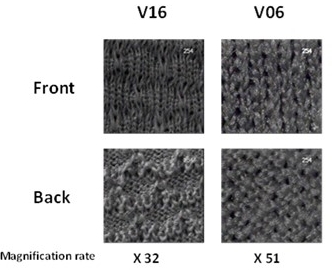The effect of fabric’s structure on the breathability and the drying rate Properties
DOI:
https://doi.org/10.25367/cdatp.2021.2.p61-69Keywords:
Air permeability, Water vapor permeability, Clothing comfort, Drying rate,Abstract
Many parameters affect sportswear comfort. Therefore, we selected five sportswear fabrics designed for jogging and hiking T-shirts to study their structural characteristics and to investigate the influence of these characteristics on the clothing comfort properties. The areal weight, the thickness, the loop length and the course and wales densities were calculated. Investigations were performed on air permeability, water vapor resistance and drying time/rate properties of selected fabrics. We found that an increase in the mass per square meter and in thickness decreases the air permeability and increases the water vapor resistance of knitted fabrics. The air permeability is proportional to the loop length, while the water vapor resistance is inversely proportional to the loop length. Finally we did not find any significant relation between the fabric’s structure characteristics and the drying time/rate.
References
Apurba Das and Ramsamy Alagirusamy. 2010. Science in Clothing Comfort, Vol. 2: Psychology and Comfort, Woodhead Publishing India Pvt. Ltd.
Daniel Wendt, Luc van Loon and Wouter van Marken Lichtenbelt. Thermoregulation during exercise in the heat strategies for maintaining health and performance. Sports Med. 2007, 37, 669-682.
Dinesh Bhatia and Urvashi Malhotra. 2016. Thermophysiological wear comfort of clothing: an overview. J. Textile Sci. Eng. 2016, 6, 1000250. DOI: https://doi.org/10.4172/2165-8064.1000250.
Esra Taştan Özkan and Binnaz Meriç Kaplangiray. Investigating thermophysiological comfort properties of polyester knitted fabrics. J. Textile Eng. Fashion Technol. 2019, 5, 50-56.
Daiva Mikučionienė, Laima Milašiūtė, Rimvydas Milašius. Influence of knits structure on flammability and comfortability. AUTEX Res. J. 2014, 14, 226-232. DOI: https://doi.org/10.2478/aut-2014-0022.
Ebru Çoruh. Optimization of comfort properties of single jersey knitted fabrics. FIBRES & TEXTILES in Eastern Europe 2015, 23, 66-72. DOI: https://doi.org/10.5604/12303666.1152728.
Figen Selli, Yıldıray Turhan. 2017. Investigation of air permeability and moisture management properties of the commercial single jersey and rib knitted fabrics. Tekstil ve Konfeksiyon 2017, 27, 27-31.
Esra Karaca, Nalan Kahraman, Sunay Omeroglu and Behcet Becerir. Effects of fiber cross sectional shape and weave pattern on thermal comfort properties of polyester woven fabrics. FIBRES & TEXTILES in Eastern Europe 2012, 20, 67-72.
M. B. Sampath, Senthilkumar Mani and Govindan Nalankilli. Effect of filament fineness on comfort characteristics of moisture management finished polyester knitted fabrics. J. Ind. Text. 2011, 41, 160-173. DOI: https://doi.org/10.1177/1528083711400774.
Air Permeability Tester FX 3300 LABOTESTER III; ARTEC TESTNOLOGY manual.
Lubos Hes. Non-destructive determination of comfort parameters during marketing of functional garments and clothing. Indian Journal of Fibre & Textile Research 2008, 33, 239-245.
Banu Özgen and Sevda Altaş. The investigation of thermal comfort, moisture management and handle properties of knitted fabrics made of various fibres. Tekstil ve Konfeksiyon 2014, 24, 272-278.
Amel Boughattas, Sofien Benltoufa and Faten Fayala. Moisture management properties of double face denim fabrics. International Journal of Applied Research on Textile 2019, Special Issue Cirat-8, 38-43.
ISO 17617:2014 Textiles — Determination of moisture drying rate.

Downloads
Published
How to Cite
Issue
Section
License
Copyright (c) 2021 Mohamed Ghaith Chakroun, Sofien Benltoufa, Faten Fayala

This work is licensed under a Creative Commons Attribution-NonCommercial-NoDerivatives 4.0 International License.





